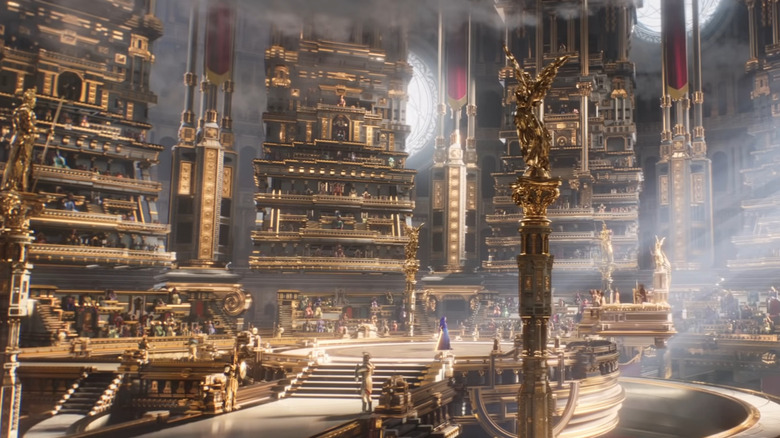What Only Hardcore Marvel Fans Know About Thor: Love And Thunder's Omnipotence City
Contains spoilers for "Thor: Love and Thunder"
"Thor: Love and Thunder" catches up with Thor (Chris Hemsworth) following the events of "Avengers: Endgame" as he takes the time to care for himself and find inner peace. Naturally, his plans are thwarted when he is thrust into another whirlwind cosmic journey that sees him re-team with Korg (Taika Waititi), Valkyrie (Tessa Thompson), and Jane Foster (Natalie Portman), now known as The Mighty Thor. The quartet goes up against the vengeful Gorr the God Butcher (Christian Bale). After breathing new life into Thor with "Thor: Ragnarok" in 2017, Waititi, who directs in addition to playing the lovable Korg, ups the Saturday morning cartoon levels of absurdity with more humor, bigger spectacle, and a host of new characters and concepts that add an explosion of energy to the already ambitious heights of the MCU's Phase 4.
But, for comic book fans, many of these concepts are nothing new; rather, they are lifted from years of comics source material to be lovingly adapted on the big screen. Whether the accuracy of these depictions works or not is up for debate, but it is nevertheless commendable to see the lengths the MCU continues to go in bringing these iconic characters and worlds to life. One of these fascinating worlds depicted in "Thor: Love and Thunder" is that of Omnipotence City, where Thor and his allies go to ask Zeus (Russell Crowe) for an army to help in battling Gorr.
While more casual viewers may see Omnipotence City as no more than a gleaming new world, comic fans know there's a lot more that the location has to offer than meets the eye.
Omnipotence City is full of gods — and some dark secrets
While much of what happens in "Thor: Love and Thunder" takes inspiration from Jason Aaron's "The Mighty Thor" run (via Deadline), it also appears that many of its concepts originate from Aaron's "Thor: God of Thunder" run, co-created with artist Esad Ribic. First appearing in 2012's "Thor: God of Thunder" Vol. 1 #3, Omnipotence City is said to be a 12 billion-year-old civilization built as a nexus place for all gods and deities (2016's "Mighty Thor" Vol. 3 #12 tweaked the age of Omnipotence City, adjusting the location's age to 4 billion years old). The floating metropolis acts as a neutral ground for all gods, whether they are seen as elders, lesser gods, demigods, and so forth.
Thor's mission when entering the citadel is to seek out the Lord Librarian in the legendary Halls of All-Knowing, to help him look for information about other gods that have vanished and might be in danger from Gorr. Thor is taken to the Hall of the Lost, where gods whose lives are lost or are no longer remembered remain. Upon arrival, Thor is shocked by the number of vanquished gods and deities (via CBR). "Thor: Love and Thunder" doesn't spend quite as much time in Omnipotence City to explore these secrets, rather seeing Thor and his allies interact with Zeus and some other gods in a more light-hearted sequence.
Will we be seeing more of Omnipotence City in future installments and possibly get a glimpse at some of the darker corners of the shining city? Only time will tell, but for now, we can appreciate both versions for what they offer.

